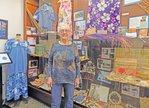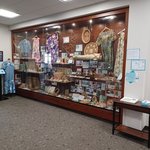Julie Hartzler Zahs created a museum-quality exhibit of crafts, clothing, and other items that illustrate her experience in the Peace Corps in the Marshall Islands 50 years ago at Hills Bank in …
This item is available in full to subscribers.
We have recently launched a new and improved website. To continue reading, you will need to either log into your subscriber account, or purchase a new subscription.
If you had a login with the previous version of our e-edition, then you already have a login here. You just need to reset your password by clicking here.
If you are a current print subscriber, you can set up a free website account by clicking here.
Otherwise, click here to view your options for subscribing.
Please log in to continue |
|


Julie Hartzler Zahs created a museum-quality exhibit of crafts, clothing, and other items that illustrate her experience in the Peace Corps in the Marshall Islands 50 years ago at Hills Bank in Washington. The temporary exhibit will move to Dubuque in May; until then, it is viewable during bank hours. Zahs has many fascinating stories to tell about her experience and the items she brought back with her and is available to share them with you at the bank on most weekday afternoons and Saturday mornings by appointment. It is well worth your time to have her take you through the exhibit; her warm and engaging personality is infectious. This is her story.
I grew up in Kalona, and after graduating from Iowa State University, I joined the Peace Corps.
I spent two years in the Peace Corps from 1972-74 serving as a teacher in the Marshall Islands, which are located in the Pacific Ocean. (My father was a Marine there in WWII when he did airplane maintenance on Eniwetok Atoll. The islands had been controlled by the Japanese; the Marshalls became a US Trust Territory after the war.)
I served two years on remote outer islands, each of which had about 180 locals. I was the only American on the islands, so I needed to use the Marshallese language I learned during my three-month training.
My first year I served on Utrik Atoll and the second year on Woja, Ailinglaplap. I traveled between the atolls on a cargo ship that collected dried coconut meat (copra) from the locals and sold them rice, flour, sugar, coffee, yeast, tea, matches, tobacco, canned milk, etc. These ships came every three to four months, so one had to plan ahead. This is also when I received and sent mail. Christmas cards came in February!
Teaching English and math to students in various grades from 1-8 was my main job. I was to help prepare 8th graders for their high school entrance exam. I also taught 1st graders to read and write in Marshallese, taught baking classes to women using a 55-gallon drum (oven) buried in the ground, and taught evening English classes to adults. Their language was written phonetically by the missionaries, so it was easier to teach the kids to
read and write in Marshallese.
My first day with 1st graders, we were sitting outside where I was sharing a book with them.A little girl got up and started ‘fingering through my hair.’ Suddenly she announced to the class, “The white person has no lice!”
I had to chuckle. Their name for white person translates as “person who brings clothing”, as it referred to the white missionaries.
I had fun sewing on a hand cranked sewing machine as I sat on the floor. It’s possible! These ladies are very skilled seamstresses.
Women were not to show their thighs, so I swam in a dress with the kids, as island women didn’t swim. The coral and fish were like a movie for me. If I swam with my male students when they went spear fishing, I added shorts under my dress.
I learned to cook many interesting dishes using breadfruit, pandanus, coconuts, coconut sap, rice, and of course had lots of fresh fish. As a guest, the island king/queen and I were served the heads of large fish. We were honored!
Every evening, I would roll out the lovely handwoven pandanus bed mat the ladies created for me. One neighbor lady taught me to make coconut oil, which I then used on my skin. I noticed mosquitoes didn’t bother me when I used it. NICE!
The time I was helping bring in fish on a special school field trip, my finger touched a poisonous fin, causing pain. The men first rubbed an inside part of the fish on it, but it didn’t help. Then they had a young student climb a coconut tree to get a small golf ball-size coconut. After cutting it in half, they rubbed this on the wound, and it was just fine!
Another time I wacked my ankle with my machete while gathering material to make a chicken house for the 18 chickens they gave me. My neighbor man blew on the wound and sang chants to it. It got better. I must admit, I also used some ointment and tape in my Peace Corps medical supply box.
At Easter time on Utrik, the men sailed over to a nearby atoll that had hundreds of birds. They brought back many eggs, boiled them, then served 18 to each member of the island. As I cracked one of mine to eat, I noticed a cooked bird inside the shell. They informed me I was so lucky, so I tried it. Hey, it was good! I hoped for more.
We had no running water or electricity, so it was sort of like camping for two years, which was okay. Often the island’s radio didn’t work, so I had zero ways to communicate with the outside world. (I didn’t let my parents know this.)
Fortunately, I had no major health crises. The time I was sick, the locals built a huge bonfire on the ocean side one evening when they noticed a ship in the distance. This was their “SOS” message to the ship. It then came over to the island, sent in a little boat, and the locals told them there was a sick Peace Corps Volunteer on the island. They came, woke me, and got me to the ship. The ship then dropped me off at Kwajalein, a US missile base, where I was treated at a hospital there for shigella and giardia parasites. I stayed with a local family as I waited for the ship to return me to the island.
I brought back items/crafts I made, purchased from people, and/or people gave me. These folks are excellent weavers with local island materials, incorporating shells, wood, etc. When I needed a crochet hook, a guy just created one for me. Such talent! I had fun making crafts with the women. However, it took so long to make a basket, as one had to first prepare all the fibers.
Living on an isolated outer island was certainly a lifestyle of “learning to get along with everyone.” These folks shared with one another, worked together, and respected each other. I was treated very well by the islanders. The Marshallese are extremely friendly and have a great sense of humor.
When I returned to Kalona in 1974, I had a job waiting for me at the Mid-Prairie Junior High where I taught 7th grade social studies and language arts. I’ve enjoyed sharing my island experience with my students over the years. It was fun to see some of them join the Peace Corps and/or do Mennonite service around the world.
Some of the islands now have solar and wind energy to power lights, etc. Some even have an airport for small planes. And yes, some have cell phones.
The atolls of Enewetak and Bikini were famous in the 1940’s and 50’s for the test bombs our country exploded on them. One major bomb caused radiation to hurt the folks and islands of Rongelap and Utrik.
While I was on Utrik, we would get visits from the US Atomic Energy commission. People developed cancers and other illnesses from the test bombs. This is still an issue today for the Marshallese. A tiny two-piece swimsuit was created during this time, so the French designer named it “bikini” as it “rocked the beaches.”
The islanders are also experiencing global warming, as sea water is rising. Salty waves are coming onto the low atolls, hurting their shallow wells, effecting their trees, and washing out cemeteries, roads, and homes. Many Marshallese have moved to the United States where they can easily work and get government health coverage.
I have had the wonderful opportunity to get to know Marshallese folks now living in Dubuque. I have been to events they have, such as 1st year birthday parties and a wedding, college graduation, and funeral, and have been given more of their beautiful handicrafts. They know some of the islanders I knew, so they can fill me in on these folks.
The thought is to have some of my items in the display go to a display in Dubuque, but I wanted to first show them locally here in Washington.
Julie Hartzler Zahs’s display of items and photos she brought back from the Marshall Islands can be viewed at Hills Bank, 2481 Hwy 92, Washington from 9 a.m. to 5 p.m. weekdays and 9 a.m. to noon Saturdays through the end of April. If you would like her to join you at the exhibit to share more of her experience, contact her at juliezahs@gmail.com or 319-621-6785.